Maybe there is something in the difference between a battery charger and a battery maintainer? On the Home Depot website, the Black and Decker 2/4/6 amp device is labeled as a "charger" but the 2 amp device is labeled as a "maintainer". Having said that, I have the box of the Vector 2 amp devices that I bought and it has "BATTERY CHARGER" in large font written across the front and in small font above that it says "SMART AUTOMATIC FLOAT MODE BATTERY MAINTAINER". Across the bottom, it says "DEEP CYCLE - AGM - GEL - AUTO - MARINE - TRUCK - FARM EQUIPMENT & MORE"
Here's your mistake - you're expecting marketing messages to reflect truth. Since when do marketers say truth?
That's why e.g. the government has to pass laws about what is the meaning of "fruit juice" or "organic", because marketers have proven themselves over and over that they'll fudge the truth and cause misdirected misperceptions into the land of folly.
• The unit has two Charge Rate settings, controlled by one switch:
a) 2 amp: for recharging motorcycles, lawn mowers, tractors, ATVs, snowmobiles
and personal watercraft.
b) 1 amp: for maintenance charging RVs, speciality vehicles, antique and classic
cars, marine deep cycle batteries and more.
Here are the specs which explain a lot:
Input:...............................................120V AC 0.5 amps
Output:............................................Nominal 12 volt DC at up to 2 amperes
Reverse Polarity Protection ................Output battery clips short circuit protection
Bulk Charge.....................................2 amps constant current raises battery voltage
until it reaches 14.4V +/- 0.2V
Absorption.......................................Constant- holds voltage 14.4V +/- 0.2V and
forces the current to fully charge the battery
Float................................................When battery falls below 12.8V +/- 0.2V the
charger will start charging from Bulk Charge
stage again.
It doesn't have a low-voltage float, instead it just goes back into bulk phase when the voltage falls below a specified level. My guess is that the cutoff current is a bit high, meaning after cutoff the battery voltage drops below the specified level, and the charger pulses back on multiple times. It may need to do this to fully charge the battery. This may be the way the charger is designed.
If the cutoff current was set too low, than the charger may not shut off for a really large RV battery for instance. And that would damage the battery.
I wouldn't be worried about the pulsing, as long as the battery voltage indicates full charge after they sit for an extended period after finishing charging.
[url=/forum-topic/motorcycles-and-large-scooters/587-my-kz750-electric-motorcycle-project]KZ750 Motorcycle Conversion[/url]
[url=/forum-topic/motorcycles-and-large-scooters/588-fixing-my-chinese-scooter]900 watt scooter[/url]
Pic from http://www.electri
Thanks for that information. When I saw your message, I was a bit embarrassed because I assumed that I had just overlooked the detailed specifications that you posted and you ended up doing my legwork for me. I went back to the manual that came with the charger unable to understand how I had missed the information. I turned out that its not there! The design of the manual I have is similar but not exactly like the one you linked. They both have the same model number on the front, but mine only says:
It looks like the battery will have to come to rest at 13.1 in order to avoid the pulsing as you point out. I just checked them a few minutes ago, and after about 20 hours of rest, 3 of 4 are resting at 13.0 and one is at 12.9 which is better than the resting charges after my full discharge incident. Maybe I just need to allow these chargers to do their thing longer to get the resting charge up to 13.1. As you say, maybe they are designed to do this. I hope so. These chargers were attractive to me because they are small enough that I might be able to install them inside my bike (assuming overheating doesn't become a problem).
FYI, the 2 amp charger vector b&d have a KNOWN high failure rate and are to be avoided, these are the small units that do not have fans.
They are intended to trickle of float and ALREADY charged battery, and not for charging a cycled battery.
Many many people have used them for charging and they failed on trolling motors and motorcycles.
...
I came across a site on the web where a lot of people tried the 2 amp and were having high failure rates, all of them were using them for charging instead of maintaining, I think thats why they fail. Get too hot and pop.
...
I have a sneaking suspicion that if you bust one open, it is the 2 4 6 amp unit limited to 2 amps with no fan, which is ok unless it is called on to run 2 amps for hours and hours, like in a cycle application, then it gets too hot.
If someone opened them up and mounted 5 in a fan box, then they would probably work.
...
As I said, I know someone who had one fail in pretty short a time that was being used to recharge an auxiliary battery on an EV truck. I think it got really hot and stopped charging correctly. Maybe temperature is an important factor? Maybe you could even install small fans on them.
[url=/forum-topic/motorcycles-and-large-scooters/587-my-kz750-electric-motorcycle-project]KZ750 Motorcycle Conversion[/url]
[url=/forum-topic/motorcycles-and-large-scooters/588-fixing-my-chinese-scooter]900 watt scooter[/url]
Pic from http://www.electri
I'm getting erratic behavior out of these 2 amp Vector chargers (VEC080)
Of my five Vector 1086B (2/4/6amp) chargers, Charger 1 showed similar erratic behavior after nearly every full charge. This can be seen in the pics in the first few posts of this thread (red line). I bought a Black & Decker 1086BD (2/4/6amp, same as Vec1086B) to replace it. Similar behavior occurred on one other charger, but only once and hasn't happened since.
Since swapping the suspect charger with the new one (same battery), the behavior reoccurred on two of five cycles about 2-hours after full charge. However, not all of those charge cycles were left on for more than 2-hours after full charge. So I suspect this charger also has a poor setting.
I now have the chargers on a timer that shuts off 1-hour after my calculated charge time. Since adding the timer, there have been four 2-amp charges, one 6-amp charge, and one string charge, and I haven't seen anything erratic in my PT logs.
To troubleshoot, swap a suspect charger with one that functions consistently. Over the next few charges, check if behavior moves with charger or stays with battery. (In my original testing, the behavior followed the charger to the new battery pointing me to the charger)
I haven't seen posts that indicate a similar problem with other chargers. It could be unique to the Vector/B&D chargers, or perhaps no one is data logging on other chargers.
Also, from what I've read here and elsewhere, EV batts shouldn't be left on float. It would be nice if the chargers just shut completely off after full charge.
When I first put together my bank charger, I snipped away the extra charger wires to keep things clean. Doing this eliminated an exchange of the bad charger. So for any new chargers, I'll only be snipping off the terminal clamps. That way I can just solder them back on before exchanging it.
Short of putting them on a board on the back of the bike. I have no idea how I'm going to get these larger chargers to work for charging during the day, but I guess I'll figure something out. How bad would it be for the batteries if I only charged when I get home each day?
Just a quick update for anyone who is interested in the Vector chargers. The Husky 2/6/10 chargers seem to be working pretty well. I find that if I ride my Emax and then charge it (bank charging with 4 chargers / 4 batteries) I get what appears to be a normal charging cycle like this one.
(the data was sampled at one minute intervals)
If I turn the chargers on for a top-up (after the batteries have previously been charged and allowed to settle), I can get some erratic pulsing and the displays on the chargers often produce an error of an open cell.
The thing that still concerns me a little is the way the EB 20-12 batteries settle to between 12.7 and 12.9 volts. Battery 2 (as indicated in the graph above) always seems to settle lower than the others to 12.7 volts. I've read that anything below 12.6 volts is call for concern. Maybe others can advise me on whether to stop worrying and just enjoy my commute or whether to do something about it.
Also, thanks for the information posted by others about bank charging. I'm pleased so far with my Anderson Powerpole connections (thanks Chas) that allow me to easily shuffle the chargers to different batteries and hopefully make sure no one battery is getting unusual treatment.
12.7v is low, especially for a new battery. What I would do is run the scooter until the batteries are at least 80% discharged. Then, get a load tester and test all of the batteries for a short duration of a couple seconds on 100 amps or more and watch the voltage. If the 12.7v battery drops significantly more which I bet it will, than this is cause for concern. Maybe try and get a warranty replacement if you still can.
[url=/forum-topic/motorcycles-and-large-scooters/587-my-kz750-electric-motorcycle-project]KZ750 Motorcycle Conversion[/url]
[url=/forum-topic/motorcycles-and-large-scooters/588-fixing-my-chinese-scooter]900 watt scooter[/url]
Pic from http://www.electri
Thanks, Andrew. I was afraid someone knowledgeable like yourself might say this, but still appreciative for the feedback so that hopefully I can get the situation fixed.
When you recommend that I conduct the load test when the battery is 80% discharged, do you think I can safely use my PakTrakr's "State of Charge" mode to determine when I have reached that level of discharge?
I think you can. The important thing is to try and prevent doing any damage to them. You probably don't want to damage the bad one because you'll still need to use the scooter. I would cut it off any testing at 7.2v. I would do a test of 10-20 seconds for the good batteries, and a few seconds on the potential bad battery. The voltage will probably be a lot less right away and this should tell you what you need to know. If it is not, then let the test go for 10-20 seconds like the other batteries and watch the voltage like a hawk. If it drops fast, you'll want to cut the test off quickly because this means a cell in the battery is fully discharged and is being reverse charged.
This method is how I recently determined a weak battery in my motorcycle with less capacity. I rode the motorcycle until the pack felt pretty weak and I could tell that it wouldn't last much longer. This was a reduced range for some reason. Then I load tested all of the batteries at 100 then 200 amps and noted the voltage drop at each current. I didn't need a long test duration, just an instant so you my try an instant pulse test first on all of yours. Instantly the bad battery dropped to a noticeably lower voltage at 100 amps, and at 200 amps it was like 4v lower than the others.
The load tester you linked is probably a more expensive one. For a cheap one, harbor freight carries one of the 100 amp models for $10, but keep the receipt and just exchange it if you get a bad one or it breaks. Also you might check at some auto parts stores. I don't know if the 100 amp models have a switch. This is the one I have which can be turned on or off at any time with a twist of the knob.
[url=/forum-topic/motorcycles-and-large-scooters/587-my-kz750-electric-motorcycle-project]KZ750 Motorcycle Conversion[/url]
[url=/forum-topic/motorcycles-and-large-scooters/588-fixing-my-chinese-scooter]900 watt scooter[/url]
Pic from http://www.electri
You already have a load tester, it's called a PakTrakr set at one second polling and your bike on a 20 km test ride at full throttle, or as near to that as you can get.
One second polling nets 3 hours or so.
Also keep in mind PakTrakr is not highly accurate, port one for Bat one is ALWAYS over reporting by as much as 0.17 volts, you should ALWAYS subtract 0.10 from all readings from Bat 1 on the PT unit. I have contacted them on this before and they say their tests dont show that, I have two units bought 7 months apart, they both do it on 50 different bikes.
It also has rounding errors up to 0.05 and can cause deep mometary swings up or down in readings, if the reading is not consistently there, probably an anomoly.
I have calibration tested the PT to three meters, it is good for guidance only and not as a test instrument of any great accuracy.
For load testing it is adequate when used in conjunction with rapid polling and long rides as evidenced below.
Batteries one and three are bad
All batts good, nice and even
Batt3 is bad
Batt 4 is bad and 1 is going bad
Pretty good but 2 is weakest and has sulfated crystallized plates from undercharge, lots of power at beginning and burns it all off and gets to resistive part of plate and cant make power like it did in the beginning, happens with no BattEQ in charge process
I'll try the PakTrakr load test first and see what happens and then I might get a load tester which I expect could be one more handy tool to have around.
BannedAgain, your graphs made me wonder about the way Battery 2 dips lower than the rest at the greatest depth of discharge in the graph I posted above. Here it is again.
I checked the B&B warranty on their website, and they specify:
"A battery will not be considered defective unless it fails to deliver 60% of its original rated capacity during the warranty period." Its a one-year warranty.
Wow, well I think there's an answer to my question. I went out for a long ride with my PakTrakr sampling data at 1 second intervals, and now that I have downloaded the data I see that TWO batteries are behaving unlike the other two.
Here is the graph of the whole ride:
And when I focus in on the middle of the discharge, you can see more clearly that both batteries 1 and 2 are behaving identically and far below batteries 3 and 4 under load. (I had to give battery 1 a darker line just so that it wouldn't be masked by the line representing battery 2.)
I think it was when the PT "State of Charge" indicator got to 39% that the scooter started stuttering and that corresponds with the big dip in performance by batteries 1 and 2. I was near home at that point and just rode it gently back to the house.
So, I'm guessing I need get these two batteries replaced under warranty.
For reference, here is the data from my ride this morning. My batts are staying together.
[Z20A, 8.82 GPS Miles, Hilly Terrain, PakTrakr 1-second logging interval]
keep in mind PakTrakr is not highly accurate, port one for Bat one is ALWAYS over reporting by as much as 0.17 volts, you should ALWAYS subtract 0.10 from all readings from Bat 1 on the PT unit.
I have taken occasional battery voltage readings with a cheap ($20) Digital MultiMeter. Comparing the DMM readings to the PT data logs, I have found that the PakTrakr reads 0.21 Volts higher on Batt1 and 0.1 Volts higher on Batt5. All other batts are very close.
Data Note:
DMM readings were taken at the bank charger terminal strip, which correspond to readings taken directly at the battery terminals. The time the batteries sat after charging or riding varied. In some cases DMM readings were taken during charge, minutes after a ride, hours after the batts had sat idle, etc. I have not verified the DMM accuracy.
The PT temp readings aren't even close. So for long term performance evaluation under different temps, I log the temp from a digital thermometer at the bank charger.
Even with the minor variations, the PakTrakr/data logger is still a great piece of equipment! I don't know how you'd identify some of these battery/charger problems without it before the warranties run out.
I think that you did a very severe over-discharge earlier on these batteries and caused damage to multiple cells in batteries 1 and 2. I suspect that the slow, long, unattended discharge was probably the main culprit although if the batteries vented they lost some capacity from this as well. Discharging batteries slowly versus quickly usually causes a much deeper cycle which is harder for a battery to recover from. I suspect that if you feel batteries 1 and 2 after a long ride they will have multiple hot spots from cells with higher internal resistance. Discharges usually are slightly deeper for batteries near the positive end of a battery string (batteries 1 and 2.) To make things even worse the Paktrakr powers itself from battery 1 (?source of incorrect voltage reading) which is a less than ideal design IMHO. Are you running only 4 EB20-12 batteries in your Emax or do you have then buddy paired with the old batteries? Also are you using turbo mode when riding or not? The reason I ask is that with only 4 batteries you are pulling 2C in economy and 3.5C in turbo mode which is a little high especially if you are climbing hills a lot or constantly having to accelerate from stops.
BTW, this is my battery break in and maintenance process. Remove all batteries. Hook all batteries in parallel. Charge with smart charger (like 3 stage 12V soneil charger) and allow batteries to remain on float for at least 24hrs. Remove float charger and allow voltage to settle after waiting at least several hours. Measure each battery's voltage. Arrange batteries from highest to lowest voltage and number them. Connect all batteries in series (highest voltage battery at positive end and lowest at negative end of string) using the same length and gauge of wire. Attach the scooter's string charger (do not hook up backwards as cheap chinese chargers usually have no fuse or reverse polarity protection!) After a few minutes check individual battery voltage to make sure that they are okay (close in voltage preferably less than 0.05V apart.) Reinstall batteries. Take scooter for a long ride (WFO) until voltage starts to dip well into the red (usually about 10.2V for each battery under load.) Recharge with string charger and leave batteries on float for 6 hours. Do this four more times and batteries will be ready for normal riding. Try to make sure that batteries float after full charge for at least 2-6 hours once a day. I also remove, individually charge, and rotate my batteries (17AH) every 500 miles (~100 charges because average trip is 5 miles for me or uses only 30% of capacity.) You will have to adjust the rotation schedule to your batteries size and riding patterns (should be more often for smaller batteries or deeper discharges and less often for bigger batteries and shallower discharges.) My scooter has four batteries so my rotation pattern is 1234->3412->4123->2341 then repeat.
This is intensive and tedious, but I believe it is the one of the most cost-effective way to maximize the life of a string of batteries. I could buy battery balancers, but I have decided not to for financial reasons, performance concerns, and short warranty (1-2 yrs.) The only other thing that I do is use a Soneil 48V charger that I adjust for the seasons (Summer 14.1V, Winter 14.7V, Fall 14.4V, and Spring 14.4V/per battery during bulk charge) as I ride year-round rain or shine. I have used two cheap generic chinese chargers that both charged too high during bulk charge (both over 15V per battery) and took too long to switch to float charge. The result was gassing (overt and covert) during summer and after very long rides. Needless to say I no longer use them but keep one at home and one at work just in case the Soneil fails for some reason.
I don't see a problem with using them. The main thing with gel batteries is the performance is similar to floodeds, and the cold weather performance will also be fairly poor. I would check with the manufacturer to see how they will stand up to high-rate discharge current. You will probably need 200-250 amps at least out of them.
The price is kind of steep. I would check a local Trojan battery distributor and see if you can get some of theirs instead. Go here and select 6v-Gel: Trojan-Battery this corresponds almost exactly to the Deka battery, and I bet you could find them for around $180/ea in an order of 8.
To break them in, just go easy on them for the first few cycles and run <1/2 the max range.
[url=/forum-topic/motorcycles-and-large-scooters/587-my-kz750-electric-motorcycle-project]KZ750 Motorcycle Conversion[/url]
[url=/forum-topic/motorcycles-and-large-scooters/588-fixing-my-chinese-scooter]900 watt scooter[/url]
Pic from http://www.electri
If you chose to get a gel battery, the most important this is to get a proper charger and monitor it closely at first. Gel batteries at room temperature should not be charged more than 14.1V for a 12V battery or 7.05V for a 6V battery. If they are charged at a higher voltage the number of cycles you will get from them will drop dramatically. Of course the voltage will need go up some at lower temperature (14.4V) and down in higher temperature (13.8V.) You will need 16 batteries (battery is a 6V gel model) which will weigh about 1100 lbs so make sure that your donor vehicle is up to the task because it may need suspension upgrades to support the extra weight. These batteries will be a significant investment ($3-4K+) so you may want to purchase two 48V BattEQ (BEQ-LA-4-200) to protect the 96V battery string from becoming seriously imbalanced. Good luck with the conversion.
To balance all of the batteries properly, I think the BattEQ units need to overlap. So, for a 96v system, I think he would need one 5-battery unit, and one 4-battery unit. And yes, the charge voltage is crucial. Don't listen to anyone that says otherwise, and that an AGM charger can be used. Follow the specs put out by the manufacturer, and measure the charge voltage to make sure it doesn't go too high. Don't trust the charger manufacturers if you order a charger specifically programmed for gel batteries. Measure the voltage during charge, and if it goes too high, send the charger back.
Better yet, find a charger where you can adjust the voltage manually if at all possible.
[url=/forum-topic/motorcycles-and-large-scooters/587-my-kz750-electric-motorcycle-project]KZ750 Motorcycle Conversion[/url]
[url=/forum-topic/motorcycles-and-large-scooters/588-fixing-my-chinese-scooter]900 watt scooter[/url]
Pic from http://www.electri
I expect this is the last time I will post in this incredibly long thread. I just thought I would give a final update on my two batteries that seemed to have open cells.
When I contacted B&B Batteries, they encouraged me to charge the batteries for up to 16 hours. I was a bit skeptical, especially as my Vector chargers turn off when they sense that each battery is full. At any rate, I left the chargers on for 16 hours and conducted another "load test" by riding the bike and downloading the PakTrakr data.
Batteries 1 and 2 were still underperforming but to a lesser degree, so I charged them for another extended period and conducted another load test and found that the batteries seem to be back in sync. If anything, batteries 2 and 3 now seem to be lagging slightly behind.
The batteries are also resting at 12.9 or 13.0 volts after charging, which is better than the 12.7-12.8 voltages that they were resting at.
So, it seems that after the nearly full discharge (with the 2 amp brake light bulbs) two of the batteries somehow were never fully charged, probably because I turned the chargers off each time after they said the batteries were full. (I thought this would prevent the batteries getting cooked.) I hope I'm back on the right track now.
Yea, what I meant was n chargers each connected to one of n batteries in series.
I'm not so sure about the reliability of the 2 amp vector chargers. Someone I know got one at walmart that failed pretty quick.
[url=/forum-topic/motorcycles-and-large-scooters/587-my-kz750-electric-motorcycle-project]KZ750 Motorcycle Conversion[/url]
[url=/forum-topic/motorcycles-and-large-scooters/588-fixing-my-chinese-scooter]900 watt scooter[/url]
Pic from http://www.electri
Maybe there is something in the difference between a battery charger and a battery maintainer? On the Home Depot website, the Black and Decker 2/4/6 amp device is labeled as a "charger" but the 2 amp device is labeled as a "maintainer". Having said that, I have the box of the Vector 2 amp devices that I bought and it has "BATTERY CHARGER" in large font written across the front and in small font above that it says "SMART AUTOMATIC FLOAT MODE BATTERY MAINTAINER". Across the bottom, it says "DEEP CYCLE - AGM - GEL - AUTO - MARINE - TRUCK - FARM EQUIPMENT & MORE"
Here's your mistake - you're expecting marketing messages to reflect truth. Since when do marketers say truth?
That's why e.g. the government has to pass laws about what is the meaning of "fruit juice" or "organic", because marketers have proven themselves over and over that they'll fudge the truth and cause misdirected misperceptions into the land of folly.
- David Herron, The Long Tail Pipe, davidherron.com, 7gen.com, What is Reiki
I reviewed the manual for the VEC080.
On page 5:
Here are the specs which explain a lot:
It doesn't have a low-voltage float, instead it just goes back into bulk phase when the voltage falls below a specified level. My guess is that the cutoff current is a bit high, meaning after cutoff the battery voltage drops below the specified level, and the charger pulses back on multiple times. It may need to do this to fully charge the battery. This may be the way the charger is designed.
If the cutoff current was set too low, than the charger may not shut off for a really large RV battery for instance. And that would damage the battery.
I wouldn't be worried about the pulsing, as long as the battery voltage indicates full charge after they sit for an extended period after finishing charging.
[url=/forum-topic/motorcycles-and-large-scooters/587-my-kz750-electric-motorcycle-project]KZ750 Motorcycle Conversion[/url]
[url=/forum-topic/motorcycles-and-large-scooters/588-fixing-my-chinese-scooter]900 watt scooter[/url]
Pic from http://www.electri
Andrew:
Thanks for that information. When I saw your message, I was a bit embarrassed because I assumed that I had just overlooked the detailed specifications that you posted and you ended up doing my legwork for me. I went back to the manual that came with the charger unable to understand how I had missed the information. I turned out that its not there! The design of the manual I have is similar but not exactly like the one you linked. They both have the same model number on the front, but mine only says:
[b]SPECIFICATIONS[/b]
Input: 120 volts AC, 60 Hz, 0.5 amps
Output: 12 volts DC, 2/1 amps
It looks like the battery will have to come to rest at 13.1 in order to avoid the pulsing as you point out. I just checked them a few minutes ago, and after about 20 hours of rest, 3 of 4 are resting at 13.0 and one is at 12.9 which is better than the resting charges after my full discharge incident. Maybe I just need to allow these chargers to do their thing longer to get the resting charge up to 13.1. As you say, maybe they are designed to do this. I hope so. These chargers were attractive to me because they are small enough that I might be able to install them inside my bike (assuming overheating doesn't become a problem).
Again, thanks.
It's good that you have a Pak Trakr, because it appears that these chargers may be unreliable.
Re: Deltran 5 and 10 bank 2 amp 4 stage chargers
Here's what an anonymous source has to say:
As I said, I know someone who had one fail in pretty short a time that was being used to recharge an auxiliary battery on an EV truck. I think it got really hot and stopped charging correctly. Maybe temperature is an important factor? Maybe you could even install small fans on them.
[url=/forum-topic/motorcycles-and-large-scooters/587-my-kz750-electric-motorcycle-project]KZ750 Motorcycle Conversion[/url]
[url=/forum-topic/motorcycles-and-large-scooters/588-fixing-my-chinese-scooter]900 watt scooter[/url]
Pic from http://www.electri
Of my five Vector 1086B (2/4/6amp) chargers, Charger 1 showed similar erratic behavior after nearly every full charge. This can be seen in the pics in the first few posts of this thread (red line). I bought a Black & Decker 1086BD (2/4/6amp, same as Vec1086B) to replace it. Similar behavior occurred on one other charger, but only once and hasn't happened since.
Since swapping the suspect charger with the new one (same battery), the behavior reoccurred on two of five cycles about 2-hours after full charge. However, not all of those charge cycles were left on for more than 2-hours after full charge. So I suspect this charger also has a poor setting.
I now have the chargers on a timer that shuts off 1-hour after my calculated charge time. Since adding the timer, there have been four 2-amp charges, one 6-amp charge, and one string charge, and I haven't seen anything erratic in my PT logs.
To troubleshoot, swap a suspect charger with one that functions consistently. Over the next few charges, check if behavior moves with charger or stays with battery. (In my original testing, the behavior followed the charger to the new battery pointing me to the charger)
I haven't seen posts that indicate a similar problem with other chargers. It could be unique to the Vector/B&D chargers, or perhaps no one is data logging on other chargers.
Also, from what I've read here and elsewhere, EV batts shouldn't be left on float. It would be nice if the chargers just shut completely off after full charge.
When I first put together my bank charger, I snipped away the extra charger wires to keep things clean. Doing this eliminated an exchange of the bad charger. So for any new chargers, I'll only be snipping off the terminal clamps. That way I can just solder them back on before exchanging it.
Andrew:
Again, thanks for the new information.
I just checked the PT data from my second ride, and the erratic behavior was there again on two of the chargers.
I guess I'm going to switch to the Vector / Black & Decker 2/4/6 Amp Charger or their 2/6/10 amp version. The Husky 2/6/10 amp charger seems to be identical to the Vector/B&D one). I appreciate mikejuv's suggestion of figuring out whether its the battery or the charger, but given Andrew's warning, I think I had better switch regardless.
Short of putting them on a board on the back of the bike. I have no idea how I'm going to get these larger chargers to work for charging during the day, but I guess I'll figure something out. How bad would it be for the batteries if I only charged when I get home each day?
Just a quick update for anyone who is interested in the Vector chargers. The Husky 2/6/10 chargers seem to be working pretty well. I find that if I ride my Emax and then charge it (bank charging with 4 chargers / 4 batteries) I get what appears to be a normal charging cycle like this one.
(the data was sampled at one minute intervals)
If I turn the chargers on for a top-up (after the batteries have previously been charged and allowed to settle), I can get some erratic pulsing and the displays on the chargers often produce an error of an open cell.
The thing that still concerns me a little is the way the EB 20-12 batteries settle to between 12.7 and 12.9 volts. Battery 2 (as indicated in the graph above) always seems to settle lower than the others to 12.7 volts. I've read that anything below 12.6 volts is call for concern. Maybe others can advise me on whether to stop worrying and just enjoy my commute or whether to do something about it.
Also, thanks for the information posted by others about bank charging. I'm pleased so far with my Anderson Powerpole connections (thanks Chas) that allow me to easily shuffle the chargers to different batteries and hopefully make sure no one battery is getting unusual treatment.
12.7v is low, especially for a new battery. What I would do is run the scooter until the batteries are at least 80% discharged. Then, get a load tester and test all of the batteries for a short duration of a couple seconds on 100 amps or more and watch the voltage. If the 12.7v battery drops significantly more which I bet it will, than this is cause for concern. Maybe try and get a warranty replacement if you still can.
[url=/forum-topic/motorcycles-and-large-scooters/587-my-kz750-electric-motorcycle-project]KZ750 Motorcycle Conversion[/url]
[url=/forum-topic/motorcycles-and-large-scooters/588-fixing-my-chinese-scooter]900 watt scooter[/url]
Pic from http://www.electri
Thanks, Andrew. I was afraid someone knowledgeable like yourself might say this, but still appreciative for the feedback so that hopefully I can get the situation fixed.
With regard to load testers, will these $60 100-125 amp devices do the job?
http://www.nextag.com/12-volt-battery-load-testers/search-html
Perhaps you or others have a favorite product?
When you recommend that I conduct the load test when the battery is 80% discharged, do you think I can safely use my PakTrakr's "State of Charge" mode to determine when I have reached that level of discharge?
I think you can. The important thing is to try and prevent doing any damage to them. You probably don't want to damage the bad one because you'll still need to use the scooter. I would cut it off any testing at 7.2v. I would do a test of 10-20 seconds for the good batteries, and a few seconds on the potential bad battery. The voltage will probably be a lot less right away and this should tell you what you need to know. If it is not, then let the test go for 10-20 seconds like the other batteries and watch the voltage like a hawk. If it drops fast, you'll want to cut the test off quickly because this means a cell in the battery is fully discharged and is being reverse charged.
This method is how I recently determined a weak battery in my motorcycle with less capacity. I rode the motorcycle until the pack felt pretty weak and I could tell that it wouldn't last much longer. This was a reduced range for some reason. Then I load tested all of the batteries at 100 then 200 amps and noted the voltage drop at each current. I didn't need a long test duration, just an instant so you my try an instant pulse test first on all of yours. Instantly the bad battery dropped to a noticeably lower voltage at 100 amps, and at 200 amps it was like 4v lower than the others.
The load tester you linked is probably a more expensive one. For a cheap one, harbor freight carries one of the 100 amp models for $10, but keep the receipt and just exchange it if you get a bad one or it breaks. Also you might check at some auto parts stores. I don't know if the 100 amp models have a switch. This is the one I have which can be turned on or off at any time with a twist of the knob.
[url=/forum-topic/motorcycles-and-large-scooters/587-my-kz750-electric-motorcycle-project]KZ750 Motorcycle Conversion[/url]
[url=/forum-topic/motorcycles-and-large-scooters/588-fixing-my-chinese-scooter]900 watt scooter[/url]
Pic from http://www.electri
You already have a load tester, it's called a PakTrakr set at one second polling and your bike on a 20 km test ride at full throttle, or as near to that as you can get.
One second polling nets 3 hours or so.
Also keep in mind PakTrakr is not highly accurate, port one for Bat one is ALWAYS over reporting by as much as 0.17 volts, you should ALWAYS subtract 0.10 from all readings from Bat 1 on the PT unit. I have contacted them on this before and they say their tests dont show that, I have two units bought 7 months apart, they both do it on 50 different bikes.
It also has rounding errors up to 0.05 and can cause deep mometary swings up or down in readings, if the reading is not consistently there, probably an anomoly.
I have calibration tested the PT to three meters, it is good for guidance only and not as a test instrument of any great accuracy.
For load testing it is adequate when used in conjunction with rapid polling and long rides as evidenced below.
Batteries one and three are bad
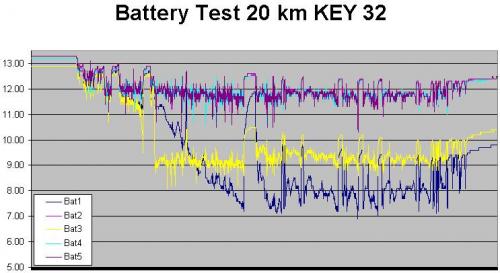
All batts good, nice and even
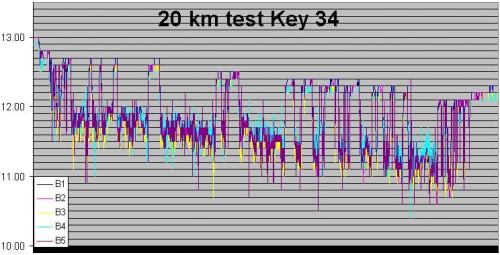
Batt3 is bad
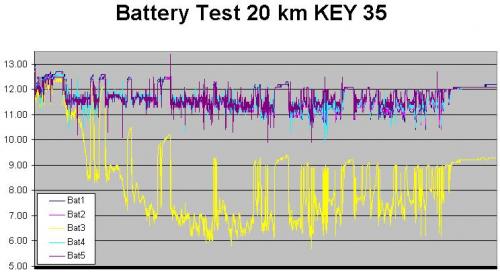
Batt 4 is bad and 1 is going bad
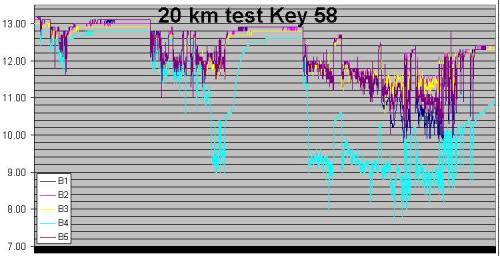
Pretty good but 2 is weakest and has sulfated crystallized plates from undercharge, lots of power at beginning and burns it all off and gets to resistive part of plate and cant make power like it did in the beginning, happens with no BattEQ in charge process
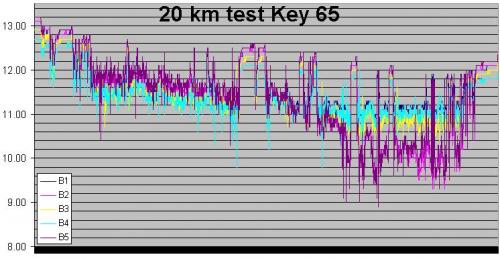
All good
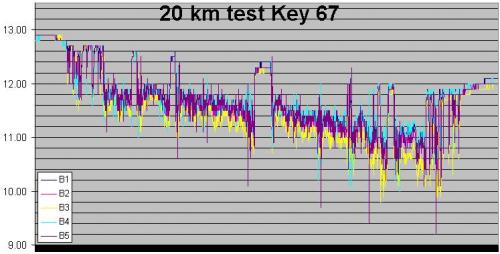
All good
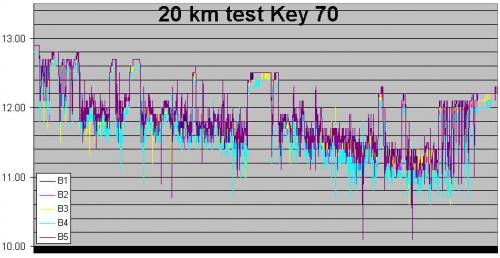
LOLOLOL V!
I'll try the PakTrakr load test first and see what happens and then I might get a load tester which I expect could be one more handy tool to have around.
BannedAgain, your graphs made me wonder about the way Battery 2 dips lower than the rest at the greatest depth of discharge in the graph I posted above. Here it is again.
I checked the B&B warranty on their website, and they specify:
"A battery will not be considered defective unless it fails to deliver 60% of its original rated capacity during the warranty period." Its a one-year warranty.
Thanks.
Wow, well I think there's an answer to my question. I went out for a long ride with my PakTrakr sampling data at 1 second intervals, and now that I have downloaded the data I see that TWO batteries are behaving unlike the other two.
Here is the graph of the whole ride:
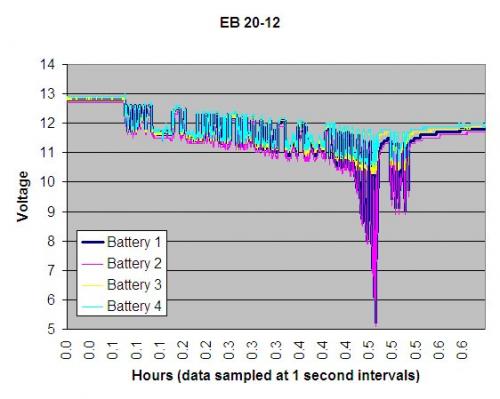
And when I focus in on the middle of the discharge, you can see more clearly that both batteries 1 and 2 are behaving identically and far below batteries 3 and 4 under load. (I had to give battery 1 a darker line just so that it wouldn't be masked by the line representing battery 2.)
I think it was when the PT "State of Charge" indicator got to 39% that the scooter started stuttering and that corresponds with the big dip in performance by batteries 1 and 2. I was near home at that point and just rode it gently back to the house.
So, I'm guessing I need get these two batteries replaced under warranty.
For reference, here is the data from my ride this morning. My batts are staying together.
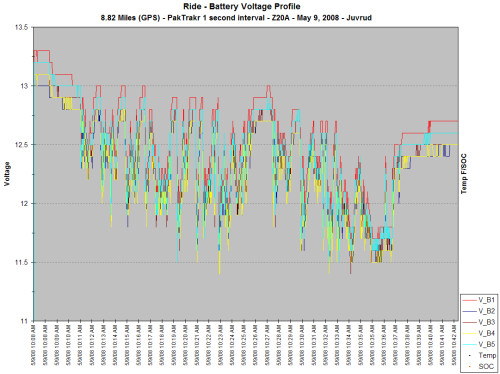
[Z20A, 8.82 GPS Miles, Hilly Terrain, PakTrakr 1-second logging interval]
I have taken occasional battery voltage readings with a cheap ($20) Digital MultiMeter. Comparing the DMM readings to the PT data logs, I have found that the PakTrakr reads 0.21 Volts higher on Batt1 and 0.1 Volts higher on Batt5. All other batts are very close.
Data Note:
DMM readings were taken at the bank charger terminal strip, which correspond to readings taken directly at the battery terminals. The time the batteries sat after charging or riding varied. In some cases DMM readings were taken during charge, minutes after a ride, hours after the batts had sat idle, etc. I have not verified the DMM accuracy.
The PT temp readings aren't even close. So for long term performance evaluation under different temps, I log the temp from a digital thermometer at the bank charger.
Even with the minor variations, the PakTrakr/data logger is still a great piece of equipment! I don't know how you'd identify some of these battery/charger problems without it before the warranties run out.
E-commuter,
I think that you did a very severe over-discharge earlier on these batteries and caused damage to multiple cells in batteries 1 and 2. I suspect that the slow, long, unattended discharge was probably the main culprit although if the batteries vented they lost some capacity from this as well. Discharging batteries slowly versus quickly usually causes a much deeper cycle which is harder for a battery to recover from. I suspect that if you feel batteries 1 and 2 after a long ride they will have multiple hot spots from cells with higher internal resistance. Discharges usually are slightly deeper for batteries near the positive end of a battery string (batteries 1 and 2.) To make things even worse the Paktrakr powers itself from battery 1 (?source of incorrect voltage reading) which is a less than ideal design IMHO. Are you running only 4 EB20-12 batteries in your Emax or do you have then buddy paired with the old batteries? Also are you using turbo mode when riding or not? The reason I ask is that with only 4 batteries you are pulling 2C in economy and 3.5C in turbo mode which is a little high especially if you are climbing hills a lot or constantly having to accelerate from stops.
BTW, this is my battery break in and maintenance process. Remove all batteries. Hook all batteries in parallel. Charge with smart charger (like 3 stage 12V soneil charger) and allow batteries to remain on float for at least 24hrs. Remove float charger and allow voltage to settle after waiting at least several hours. Measure each battery's voltage. Arrange batteries from highest to lowest voltage and number them. Connect all batteries in series (highest voltage battery at positive end and lowest at negative end of string) using the same length and gauge of wire. Attach the scooter's string charger (do not hook up backwards as cheap chinese chargers usually have no fuse or reverse polarity protection!) After a few minutes check individual battery voltage to make sure that they are okay (close in voltage preferably less than 0.05V apart.) Reinstall batteries. Take scooter for a long ride (WFO) until voltage starts to dip well into the red (usually about 10.2V for each battery under load.) Recharge with string charger and leave batteries on float for 6 hours. Do this four more times and batteries will be ready for normal riding. Try to make sure that batteries float after full charge for at least 2-6 hours once a day. I also remove, individually charge, and rotate my batteries (17AH) every 500 miles (~100 charges because average trip is 5 miles for me or uses only 30% of capacity.) You will have to adjust the rotation schedule to your batteries size and riding patterns (should be more often for smaller batteries or deeper discharges and less often for bigger batteries and shallower discharges.) My scooter has four batteries so my rotation pattern is 1234->3412->4123->2341 then repeat.
This is intensive and tedious, but I believe it is the one of the most cost-effective way to maximize the life of a string of batteries. I could buy battery balancers, but I have decided not to for financial reasons, performance concerns, and short warranty (1-2 yrs.) The only other thing that I do is use a Soneil 48V charger that I adjust for the seasons (Summer 14.1V, Winter 14.7V, Fall 14.4V, and Spring 14.4V/per battery during bulk charge) as I ride year-round rain or shine. I have used two cheap generic chinese chargers that both charged too high during bulk charge (both over 15V per battery) and took too long to switch to float charge. The result was gassing (overt and covert) during summer and after very long rides. Needless to say I no longer use them but keep one at home and one at work just in case the Soneil fails for some reason.
jbird,
Yes, I am using four batteries, but I do not use turbo mode. I climb a couple of hills on my way to work, but work is only 2.5 miles away.
Thanks for sharing your break-in and maintenance routine.
Does anyone see a huge problem with using these batteries in 96V electric car?
http://www.septechnologies.biz/index.asp?PageAction=VIEWPROD&ProdID=1575
Also, if one was to break-in these batteries is there a recommended methodology with so many?
Thanks.
Don Cristobal
EVTA Z-20b
---
Ohm is where the heart is.
I don't see a problem with using them. The main thing with gel batteries is the performance is similar to floodeds, and the cold weather performance will also be fairly poor. I would check with the manufacturer to see how they will stand up to high-rate discharge current. You will probably need 200-250 amps at least out of them.
The price is kind of steep. I would check a local Trojan battery distributor and see if you can get some of theirs instead. Go here and select 6v-Gel: Trojan-Battery this corresponds almost exactly to the Deka battery, and I bet you could find them for around $180/ea in an order of 8.
To break them in, just go easy on them for the first few cycles and run <1/2 the max range.
[url=/forum-topic/motorcycles-and-large-scooters/587-my-kz750-electric-motorcycle-project]KZ750 Motorcycle Conversion[/url]
[url=/forum-topic/motorcycles-and-large-scooters/588-fixing-my-chinese-scooter]900 watt scooter[/url]
Pic from http://www.electri
Doncristobal,
If you chose to get a gel battery, the most important this is to get a proper charger and monitor it closely at first. Gel batteries at room temperature should not be charged more than 14.1V for a 12V battery or 7.05V for a 6V battery. If they are charged at a higher voltage the number of cycles you will get from them will drop dramatically. Of course the voltage will need go up some at lower temperature (14.4V) and down in higher temperature (13.8V.) You will need 16 batteries (battery is a 6V gel model) which will weigh about 1100 lbs so make sure that your donor vehicle is up to the task because it may need suspension upgrades to support the extra weight. These batteries will be a significant investment ($3-4K+) so you may want to purchase two 48V BattEQ (BEQ-LA-4-200) to protect the 96V battery string from becoming seriously imbalanced. Good luck with the conversion.
To balance all of the batteries properly, I think the BattEQ units need to overlap. So, for a 96v system, I think he would need one 5-battery unit, and one 4-battery unit. And yes, the charge voltage is crucial. Don't listen to anyone that says otherwise, and that an AGM charger can be used. Follow the specs put out by the manufacturer, and measure the charge voltage to make sure it doesn't go too high. Don't trust the charger manufacturers if you order a charger specifically programmed for gel batteries. Measure the voltage during charge, and if it goes too high, send the charger back.
Better yet, find a charger where you can adjust the voltage manually if at all possible.
[url=/forum-topic/motorcycles-and-large-scooters/587-my-kz750-electric-motorcycle-project]KZ750 Motorcycle Conversion[/url]
[url=/forum-topic/motorcycles-and-large-scooters/588-fixing-my-chinese-scooter]900 watt scooter[/url]
Pic from http://www.electri
I expect this is the last time I will post in this incredibly long thread. I just thought I would give a final update on my two batteries that seemed to have open cells.
When I contacted B&B Batteries, they encouraged me to charge the batteries for up to 16 hours. I was a bit skeptical, especially as my Vector chargers turn off when they sense that each battery is full. At any rate, I left the chargers on for 16 hours and conducted another "load test" by riding the bike and downloading the PakTrakr data.
Batteries 1 and 2 were still underperforming but to a lesser degree, so I charged them for another extended period and conducted another load test and found that the batteries seem to be back in sync. If anything, batteries 2 and 3 now seem to be lagging slightly behind.
The batteries are also resting at 12.9 or 13.0 volts after charging, which is better than the 12.7-12.8 voltages that they were resting at.
So, it seems that after the nearly full discharge (with the 2 amp brake light bulbs) two of the batteries somehow were never fully charged, probably because I turned the chargers off each time after they said the batteries were full. (I thought this would prevent the batteries getting cooked.) I hope I'm back on the right track now.
Pages